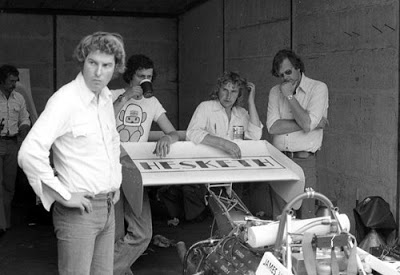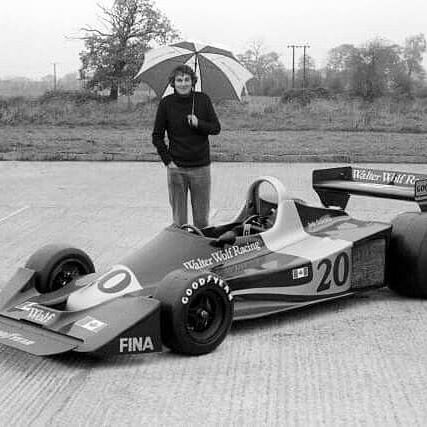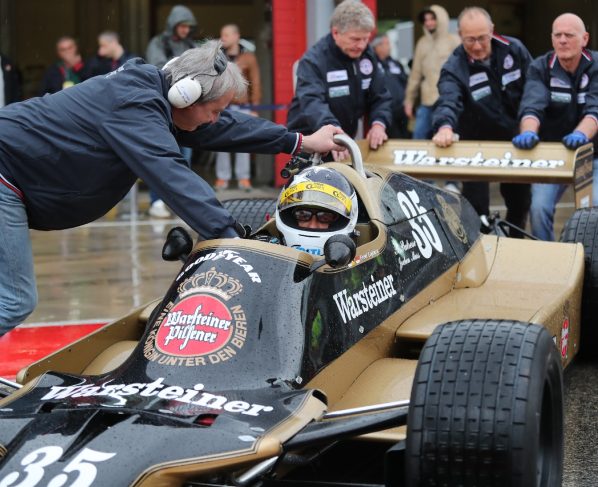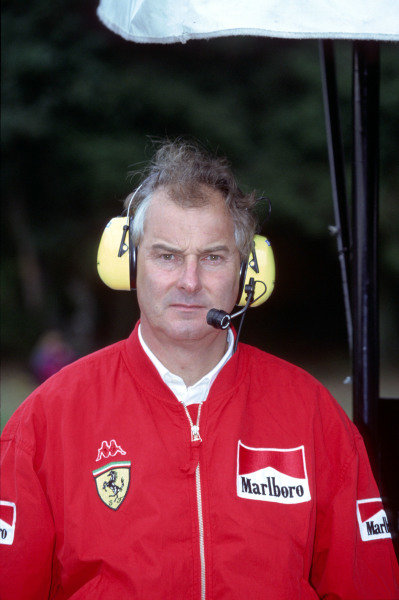Clare Topic was looking up something about Ferrari on the net when she came across our article on Harvey Postlethwaite, the legendary Ferrari engineer. She was astonished to see herself quoted so extensively as his personal assistant. She was very pleased that we continue to remember Postlethwaite as he doesn’t get much of a mention these days and yet he achieved so much. She thanked us for the article on the engineer as it was good to see Ferrari still appreciates him.
In 1994 Clare was temporarily employed to work on a project for Dr Harvey Postlethwaite using a track simulator to investigate potentially dangerous corners on Grand Prix tracks for the FIA Experts Advisory Group. In 1995 she became his Personal Assistant until the team was taken over by BAR. In addition to general secretarial support she also undertook other duties, such as developing the first in-house parts database, recording the engine performance data and she also produced a complete history of Tyrrell Formula One results, which had not actually been kept by the team. After leaving Tyrrell, she went on to complete her degree, gaining a BSc (Hons) in Mathematics in Society from the University of Middlesex. She went on to work in sports marketing analysis and then clinical research.

Despite her job with Postlethwaite was factory based, so she never actually went to the grand prix as part of the team, she learned a lot working for him and has always retained her interest in and passion for Formula 1. Sometimes she thinks that F1 has forgotten a lot of things it used to know. She had some ideas that she believes would make a real difference to Formula 1 or would make the basis for a new, really interesting and cool motorsport series.
It is with great satisfaction and pride that we publish on the website of our club the article that Clare kindly offered to give us on the great English engineer. She lived in that romantic world of which F1 was an integral part and that we strive to make known to all fans of cars, races and Ferrari. A priceless treasure to draw from and to preserve and that we are happy to share with those who follow us.
Harvey Postlethwaite – Engineer
I worked for Harvey Postlethwaite from 1994 to 1997. That was a long time ago. In fact, it was so long ago that mobile phone use was only just beginning to become common place, the world wide web was in its infancy and the Psion PDA (Personal Digital Assistant) was the coolest piece of tech you could have. Not that having “tech” was a thing back then. Engineering was perceived as a very dull profession and struggled to recruit students (although there was about to be a massive explosion in new technology). Governments weren’t that interested in promoting engineering as a profession, like they are today. Media skills was where it was at. If you wanted to work in a fast moving, high profile, exciting engineering company, Formula One was the best you could do.

Harvey came back from a university reunion one day and told me how astounded he was to discover that only one other member of his graduation class was still working as an engineer. All the others had taken early retirement or moved into other professions. As a result, when he was asked to promote engineering he was always keen to do so.
Harvey described himself as the sort of engineer that always looked up when Concorde flew over; he bought the Windows 95 operating system on the day it was launched. He also had a Psion PDA and his first job on returning from a Grand Prix was to download his notes onto his desk top PC. He always wanted to learn about new inventions. When the team were issued with the first mobile phones they liked them so much, they used them as a sort of walkie talkie in the pitlane. Unfortunately, the pitlane was in Australia and the phone calls back and forth were routed via Britain; the Accounts department had words when the subsequent phone bill arrived.
What gave him serious cause for concern was the prevailing view of the public that engineering was not a creative endeavour. He was concerned that people no longer understood how new products came into existence. For him creativity was the heart of engineering. The creativity in engineering is not just having the imagination to think up an innovative solution, but also having the skills and knowledge to turn the solution into a reality. Harvey also had the vision to see the potential in technologies. When, for example, we were networking the PCs and setting up email accounts, he was already thinking about a “paperless office” that might be possible.

Harvey was also very committed to finding and encouraging engineering talent. In these days of Rock Star tech gurus who advocate hiring lesser talents in order to remain unchallenged as the “smartest guy in the room”, Harvey’s attitude is worth reflecting on. Harvey liked to surround himself with the best minds he could find. He said that he did not want to hire the engineers who wanted to come and learn from him; he wanted to hire the engineers whom he could learn something from. He wanted the new ideas and the new technologies. Harvey never thought he knew it all and always looked to learn more. He would only quit, he said, when he could no longer keep up with the youngsters. As a result, Harvey was always the smartest guy in the room.
Of course, Harvey was passionate about Formula One. When working with him at Tyrrell, he still retained a strong affection for Ferrari and for his time working for Enzo Ferrari. There is one particular moment that I always remember when the subject of Ferrari and Harvey occurs. We worked in the Tyrrell factory building. The marketing department worked over in the cottage on the grounds. Harvey and I were walking back to the factory together from the cottage and just before we reached the factory door, we simultaneously looked over to our right and smiled. What were we looking at? Harvey’s famous, beautiful Ferrari Daytona.
Now that we live in different, technology driven times, I feel so sad that we don’t have him around. He would have been a wonderful role model and an inspiration to the generations of engineers who followed him. He was always generous with his knowledge.
 |
 |
The Formula One of today is mind blowing compared to where the sport was 25 years ago. With all the new technology and complexity of the cars, however, the human element is still very important. It is this that stops Formula One being a technology exercise and turns it into a compelling drama. It has been said that, for all the modern razzmatazz of F1, there’s something missing today. I have to say that when the new regulations were described as being “pragmatic and data led” my heart sank. There’s nothing wrong with data; data is a wonderful tool for Formula One. I am a mathematician and I love data. Data, however, informs and it confirms. It does not design. If the designers are no longer able to make bold decisions or try brilliant ideas but instead are restricted to working around a set of constraints, then the cars will reflect this. If this is the ethos then it simply won’t be exciting. All the car designs reflect their designers and Formula One needs to make space for their designers to express themselves. Harvey’s best work was like him: innovative, creative and visionary. That should be the ambition that the regulations have for Formula One.
By Clare Topic



Comments
Authorize to comment